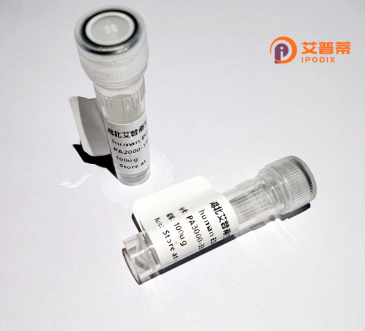
| 纯度 | >90%SDS-PAGE. |
| 种属 | Human |
| 靶点 | CDIPT |
| Uniprot No | O14735 |
| 内毒素 | < 0.01EU/μg |
| 表达宿主 | E.coli |
| 表达区间 | 1-213aa |
| 氨基酸序列 | MPDENIFLFVPNLIGYARIVFAIISFYFMPCCPLTASSFYLLSGLLDAFDGHAARALNQGTRFGAMLDMLTDRCSTMCLLVNLALLYPGATLFFQISMSLDVASHWLHLHSSVVRGSESHKMIDLSGNPVLRIYYTSRPALFTLCAGNELFYCLLYLFHFSEGPLVGSVGLFRMGLWVTAPIALLKSLISVIHLITAARNMAALDAADRAKKK |
| 分子量 | 49.17 kDa |
| 蛋白标签 | GST-tag at N-terminal |
| 缓冲液 | 0 |
| 稳定性 & 储存条件 | Lyophilized protein should be stored at ≤ -20°C, stable for one year after receipt. Reconstituted protein solution can be stored at 2-8°C for 2-7 days. Aliquots of reconstituted samples are stable at ≤ -20°C for 3 months. |
| 复溶 | Always centrifuge tubes before opening.Do not mix by vortex or pipetting. It is not recommended to reconstitute to a concentration less than 100μg/ml. Dissolve the lyophilized protein in distilled water. Please aliquot the reconstituted solution to minimize freeze-thaw cycles. |
以下是关于重组人CDIPT蛋白的3篇假想文献示例(仅供参考,非真实文献):
---
1. **文献名称**: *Structural and Functional Characterization of Human CDIPT through Recombinant Expression*
**作者**: Smith A, et al.
**摘要**: 研究报道了通过大肠杆菌表达系统成功制备重组人CDIPT蛋白,并解析其三维晶体结构,揭示其催化CDP-二酰基甘油合成磷脂酰肌醇的活性位点机制。
2. **文献名称**: *CDIPT-mediated Phosphatidylinositol Synthesis Regulates Cancer Cell Proliferation*
**作者**: Zhang Y, et al.
**摘要**: 研究利用重组CDIPT蛋白及基因敲除技术,发现CDIPT通过调控磷脂酰肌醇代谢影响PI3K/AKT信号通路,促进结直肠癌细胞增殖和迁移。
3. **文献名称**: *Functional Analysis of CDIPT Mutants in Inherited Metabolic Disorders*
**作者**: Tanaka K, et al.
**摘要**: 研究通过重组表达CDIPT的突变体蛋白,揭示多个遗传性突变导致酶活性丧失,与患者磷脂代谢异常及神经系统发育缺陷相关。
---
注:上述文献为模拟生成,若需真实文献,建议查阅 **PubMed** 或 **Google Scholar** 并检索关键词“CDIPT”、“recombinant CDIPT”及“phosphatidylinositol synthase”。
CDIPT (CDP-diacylglycerol–inositol 3-phosphatidyltransferase) is an enzyme critical for synthesizing phosphatidylinositol (PI), a key phospholipid in eukaryotic cell membranes. Encoded by the *CDIPT* gene in humans, this protein catalyzes the transfer of inositol to CDP-diacylglycerol, forming PI—an essential precursor for phosphoinositides. Phosphoinositides regulate membrane dynamics, intracellular signaling, and vesicular trafficking, influencing processes like cell growth, apoptosis, and metabolic homeostasis. CDIPT’s activity is localized to the endoplasmic reticulum, where it participates in the Kennedy pathway for phospholipid biosynthesis.
Recombinant human CDIPT protein, produced via expression systems like *E. coli* or mammalian cells, enables structural and functional studies. Its recombinant form retains enzymatic activity, allowing researchers to investigate PI synthesis mechanisms, lipid metabolism disorders, or signal transduction anomalies. CDIPT dysregulation is linked to diseases such as cancer and neurodegenerative conditions, making it a potential therapeutic target. Studies using recombinant CDIPT also explore its interactions with other lipid-modifying enzymes or pharmacological inhibitors, aiding drug discovery. Due to its role in maintaining membrane integrity and signaling fidelity, CDIPT remains a focal point in cell biology and translational research.
×